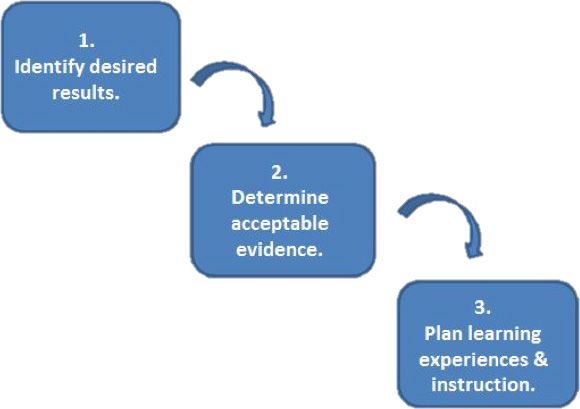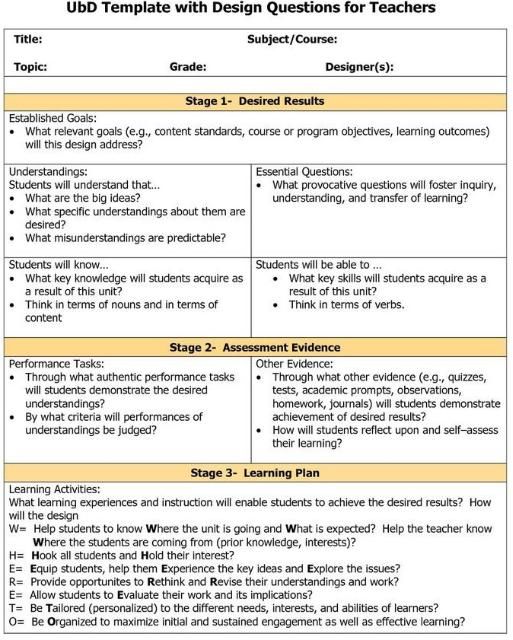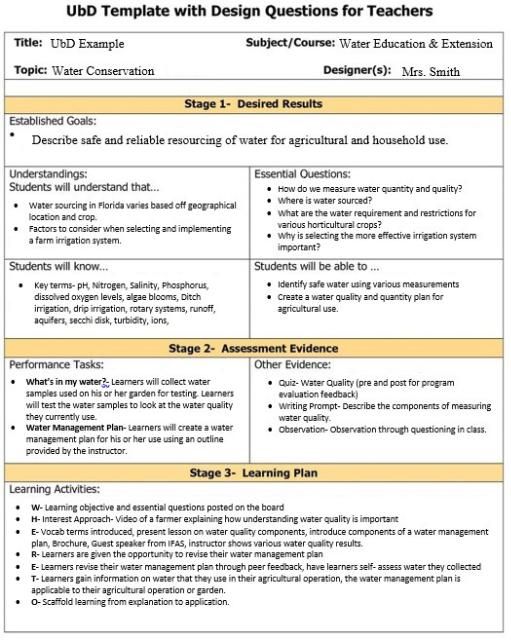Introduction
Educators serve as designers for curriculum by creating learning experiences that meet specific learning objectives for learners. The effectiveness of curricular designs is determined by whether the learners have met the specified learning goals. While the standards of what is taught often depend on whether the instruction is through formal or non-formal education, there should be a clear guide for what the student should understand and be able to do as a result of the instruction. Rather than focusing on what learning activities to offer, instructors should first plan what the learning outcomes are for their students. Using Understanding by Design (UbD) as an approach to designing curriculum allows instructors to focus on the desired learning outcomes and provide structure for student learning (Wiggins &McTighe, 2005). Using this approach, as opposed to other forms of curriculum planning, makes instructors in teaching and Extension focus primarily on the learning outcomes rather than the learning process.
What is backwards design?
The Backwards Design model focuses on learning goals as a result of instruction before planning learning activities and teaching methods. While it is important to think about what content to teach and how you would like to teach it, the focus should first be on the desired outcomes of the curriculum. Using a backwards design offers a concrete way of communicating learning expectations. Creating a clear set of learning expectations using Understanding by Design often creates higher student achievement because the organized approach outlines what is to be learned at the end of a lesson or unit. Wiggins and McTighe (2005) described Understanding by Design through three stages: a) identify desired results, b) determine acceptable evidence, and c) plan learning experiences and instruction (see Figure 1).

Credit: Wiggins & McTighe (2005)
Stage 1: Identify Desired Results
When identifying desired results, the instructor should examine the content standards to be taught and develop instructional objectives (for more information on how to create instructional objectives, see EDIS WC245/AEC583 Writing Instructional Objectives, https://edis.ifas.ufl.edu/wc245). Additionally, the instructor should review the scope and sequence of what is to be taught. As a result of reviewing the scope and sequence, instructors might find a plethora of content about which they would like to teach. However, it is important to prioritize and condense the content for clarity in an order that flows logically. Finally, it is important to be specific as possible when identifying desired results (Wiggins & McTighe, 2005). When determining desired results, some important questions to consider should be:
- What should learners be able to do, know, and understand at the end of instruction?
- What content should I be teaching?
- In what order should I be teaching content?
- What long-term understandings are desired at the end of instruction?
Stage 2: Determine Acceptable Evidence
The instructor should begin to think about how he or she will collect evidence of learning during Stage 2. This stage often involves the instructor thinking more about how they will provide evidence of student learning and proficiency before deciding how they will teach the knowledge and skills to be taught. Typically, evidence of student learning is collected in the form of assessments (i.e., quizzes, tests, projects, etc.). The assessments created should align with the desired learning results established. The Six Facets of Understanding, explained below, provides a framework on how to critically measure instructional objectives (Wiggins & McTighe, 2005). Some important questions to consider should be:
- How will I know if learners have achieved the desired results?
- What is acceptable evidence for student achievement?
Stage 3: Plan Learning Experiences & Instruction
Once desired results and evidence for understanding have been established, it is appropriate to begin planning instructional activities. Instructional activities should be purposeful in helping to establish clearly defined instructional goals while leading back to assessments created in Stage 2 (Wiggins & McTighe, 2005). The instructor should consider the learners' prior knowledge and skills when creating instructional objectives in order to challenge learners while providing scaffolding opportunities. The WHERETO elements, described below, serve as a framework for best practices when creating learning experiences and instruction. Figure 1 shows that Stage 3 is the last step because it should take into consideration the desired results and the assessments that will be collected from the learners. Some questions to consider include:
- What knowledge and skills will learners need to effectively perform and achieve the desired results?
- How can my learning activities that I have selected help my learners gain the knowledge and skills?
- How should the skills and knowledge being assessed be coached?
- What materials and resources are needed to meet my instructional goals?
Six Facets of Understanding
The Six Facets of Understanding offers a comprehensive approach in determining acceptable evidence of key ideas, concepts, and knowledge. The term "understand" is simply too broad of a term to use when measuring student learning. Therefore, the Six Facets of Understanding offers a specific approach in how the instructor would assess student learning (Wiggins & McTighe, 2005).
Explanation
Explanation is the ability to describe illustrations, theories, events, ideas, or actions. In this facet of understanding, the learner must make an account of how things work, why they work, why certain events occurred, and what they imply. This facet of understanding was first coined by Dewey (1933), who described this facet through explanation of things by noting how things work or operate, how certain things relate to one another, what are the results of those things occurring, and why certain things happen the way they do.
An example of this in an Animal Science class may include having learners explain the cattle estrous system through multiple short-answer responses. The instructor may ask for the function of certain hormones, the length of each phase, or have learners explain the estrus (standing heat) phase.
Interpretation
Interpretation is the ability to make meaning of information through narratives, data, experiences, and translations. Interpretation can be demonstrated through a variety of assessment strategies, such as interpreting significance through events, data, experiences, storytelling, or perception of particular facts. Interpretation assists learners to make sense of why certain concepts matter or how certain learning objectives relate to them (Wiggins & McTighe, 2005).
An example of this in a horticulture class may be through a fertilizer lab. In lab, the instructor might ask learners to read a section of the lab report to determine the fertilizer needs of a certain plant. At the conclusion of the lab, the instructor might ask learners to interpret some of the data produced by the class. In the lab report, the instructor might ask learners what they have concluded and have learners reflection on how their observations and data led to their conclusions.
Application
Application involves using knowledge in diverse or new situations in a real context. Learners often show proficiency in application through using knowledge and adapting it in situations that require them to synthesize about the task. Application is a skills-based approach. Kolb (1984) was one of the first to describe this facet of understanding through the experiential learning cycle, which is described as four part cycles: a) concrete experience, b) reflective observation, c) abstract conceptualization, and d) active experimentation.
- Concrete Experience: the learner encounters a new experience, or something similar to what they have experienced before.
- Reflective Observation: the learner reflects on the experience and understanding of important concepts.
- Abstract Conceptualization: the learner uses reflections to conceptualize new ideas.
- Active Experimentation: the learner applies a new idea to the world around them to see results.
Application is often measured through performance-based learning (Kolb, 1984; Wiggins & McTighe, 2005).
An example of this in a Food Science course may be through a class field trip to a local farm-to-table community garden facility. Many of the learners have never been to a facility like this in the past. At the conclusion of the field trip, the instructor asks the learners to reflect on some of the benefits provided to the community through the facility. Learners then use their reflections from their experience to create their own marketing plan for a farm-to-table community garden facility.
Perspective
Perspective is the ability to critically think through contexts using various points of view to help answer a complex question or issue. Using perspective often helps build critical- thinking skills in learners by examining conclusions, implications, traditions, or assumptions created.
An example of this in an Agricultural Foundations course may include hosting a debate in class on views regarding genetically modified food products. The instructor may ask learners to think about their viewpoint as to which they most agree with – pro-GMO or non-GMO. Once the instructor has collected learner viewpoints, the instructor would divide learners into groups based on viewpoints. Learners must use critical thinking skills to create a presentation respectfully conveying their point of view, how it differs from the opposing side, and suggest ways to determine which viewpoint is better for various societies to support.
Empathy
Empathy involves having learners go inside another person's feelings or worldview. Being able to feel for others offers an emotional perspective for learners. Empathy differs from perspective in that it does not allow us to detach the learner in an objective manner. Empathy allows the learner to go beyond his or her own opinion to making emotional meaning (Wiggins & McTighe, 2005).
In an Agricultural Foundations course, empathy may be used when discussing the common challenges that agriculturalists are currently facing. By respectfully enlightening students to some common struggles of farmers and ranchers, some of which may be occurring in their own community, the instructor is able to set emotional contexts for learners. The instructor may discuss some of the alternatives considered in the decision to close a farm/ranch, and ask learners to create an action plan for their community to solve some of the local issues.
Self-Knowledge
Self-knowledge is the ability to understand the limitations of one's knowledge in understanding an idea or concept. To reach self-knowledge, learners must be familiar with their limitation to understanding, as well as understand what each piece of information may mean to them. While it is impossible to remove bias, it is important to limit the amount of bias given in instruction. This involves not over-generalizing assumptions that are made in learning (Wiggins & McTighe, 2005). An example of this could be in an Agricultural Mechanics course. The instructor may have learners troubleshoot four different small engines to solve common issues. By doing this activity, the learners become aware of their current self-knowledge.
The WHERETO Elements
WHERETO is an acronym used to highlight key considerations of instructional design. The WHERETO elements can serve as a recipe that assesses the planned learning experiences and instruction in Stage 3. WHERETO highlights include (Wiggins & McTighe, 2005):
W—Ensure that learners understand WHERE and the unit is headed and WHY. This can be done by posting essential questions on the board, beginning the unit of instruction with the learning objectives, or ending the lesson with something to think about for the next lesson or for an upcoming lesson.
H—You can HOOK learners in the beginning and HOLD their attention throughout. This can be done as an interest approach through questioning key ideas from the lesson before, asking learners to watch a short clip that ties into the lesson, or having something at the front of the classroom that is unusual or different. There are many other activities that may hook the learners into the lesson.
E—EQUIP learners with the necessary experiences, tools, knowledge, and expertise to meet performance goals. Learners should feel able to do specific tasks associated with the learning objective. This can be done through scaffolding from prior lessons to the current lesson.
R—Provide learners with numerous opportunities to RETHINK big ideas, REFLECT on progress, and REVISE their work. Instructors may be able to do so by allowing learners to reflect on assessments for partial credit, allowing for critiques on papers from instructor feedback, or allowing time for peer review on a project.
E—Build in opportunities for learners to EVALUATE progress and self-assess. Learners should be allowed to evaluate the work that they have given to the instructor through self-assessment given via a rubric.
T—Be TAILORED to reflect individual talents, interests, styles, and needs. This aspect requires knowing what your learners prefer. If the majority of your learners prefer creative tasks rather than writing tasks, the instructor should try to focus the instructional activities more around what interests them. Tailoring student learning can occur in other ways, such as providing learners the option to do pick an assignment of their choice.
O—Be ORGANIZED to optimize deep understanding as opposed to superficial coverage. The instructor should think of the key idea or concept as the main piece of instruction in a logical flow. Oftentimes, there needs to be a summative piece to a lesson that briefly identifies what you want the lesson to take away from the lesson of the day.
UbD Template
A backwards design outline often includes each of the three stages, as well as the WHERETO elements. Below is a common UbD template used for instructors that includes key design questions (Wiggins & McTighe, 2005).

Credit: Wiggins & McTighe (2005), p. 22

Credit: Wiggins & McTighe (2005)

Credit: Wiggins & McTighe (2005)
Conclusion
Backward design is a purposeful way to design instruction, as it outlines specific results before planning instruction. Unlike other forms of lesson planning, it serves as a guide for identifying desired results, how learning will be assessed, and then adding in the instructional strategies to reach the desired results. It creates an organized system to designing instruction and provides a clear expectation of student learning. This structure promotes a well-thought out lesson from the instructor, thus promoting student achievement and mastery of understanding.
Acknowledgements
Tyler L. D'Angelo, Andrew C. Thoron
References
Dewey, J. (1933). How we think: A restatement of the relation of reflective thinking to the educative process. Henry Holt.
Kolb, D. (1984). Experiential learning: Experience as the source of learning and development. Prentice Hall.
Wiggins, G. P., & McTighe, J. (2005). Understanding by design. Association for Supervision and Curriculum Development.